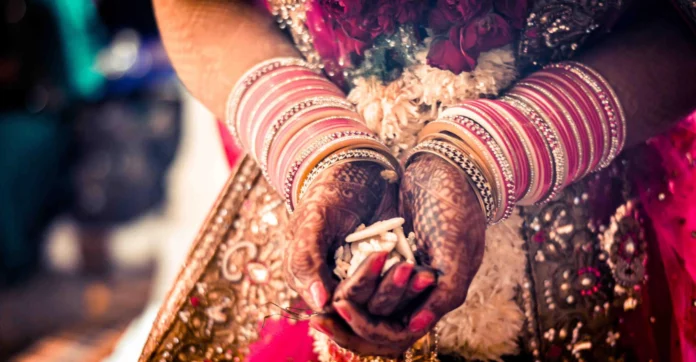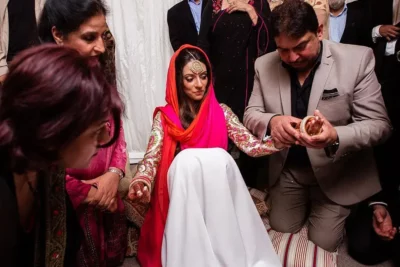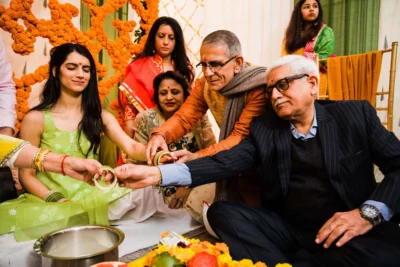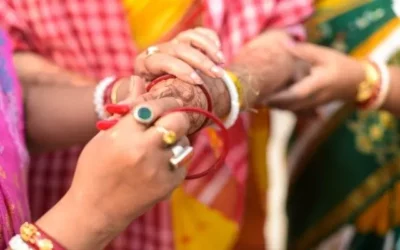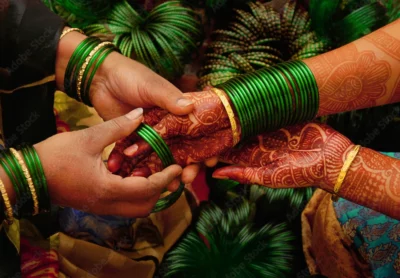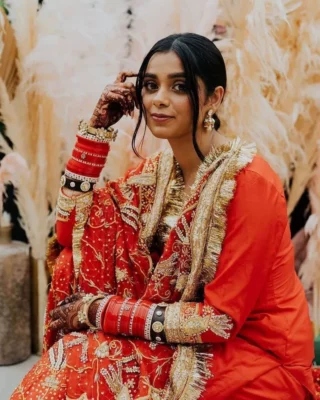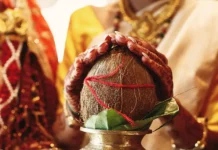When we think of Indian brides, the first thing that springs to mind is a set of vibrant and stunning bridal bangles cascading down her arms — her chooda.
Hindu weddings are vibrant, meticulously organised and culturally rich celebrations brimming with happiness and custom. While the couple’s physical, spiritual, and emotional union is the fundamental component of a Hindu wedding ceremony, it is also about the uniting of two families through celebration and prayer. Every ritual carried out during an Indian wedding has been extremely meaningful to the bride and groom regarding their respective cultures or traditions. For Indian brides, the red and white bridal choodas are personally and culturally significant. They are said to be an integral part of the solaah srinagar. Since the dawn of time, Indian brides have adorned their hands with stunning chooda sets. Today’s brides wear them with delight and diligently perform the ceremony, just as their mothers and grandmothers did. According to conventional belief, it possesses a divine and rejuvenating essence. It is a positive omen for the newlyweds since it is thought to be a symbol of prosperity and fertility. Since traditionally bare wrists are seen to be inauspicious, brides’ wrists are frequently decked with choodas on the wedding day in Hindu cultures. Hindu texts claim that they establish a safety chakra for the spouse, signifying the beginning of a lasting relationship. In Hindu marriages, it is seen as an auspicious ceremony.
In the ancient past, the brides were supposedly required to sit before four lamps after wearing the chooda till her wedding in order to attain ethereal beauty. Honeymoon is usually the stage considered to last as long as the chooda doesn’t break or be removed. Before donning them, the bride is prohibited from doing any household duties. Choodas are more than simply a bride’s ornament or accessory; they represent a married woman who has been showered with the blessings of a long and fulfilling marriage. India is a country with a diverse cultural blend and wedding customs. As part of their wedding ceremonies, women in many states don these wedding bangles in various colours and styles with various symbolic meanings.
The Significance
The importance of wearing these bangles varies from culture to culture. The bangles adornment ceremony has special significance in Hindu marriages; it is the fundamental precept. They are said to be the accessories that enhance the bride’s and her partner’s bliss. Apart from that, these bangles play a significant role in a newlywed woman’s overall aesthetic. The colours of the marriage bangles also differ from region to region. Since each bangle has its own aesthetic, it is impossible to generalise how they all appear. The metals or materials used to make these bangles have symbolic connotations. Gold is a symbol of wealth, red and white are associated with fresh beginnings and love, respectively, and green symbolises fertility, creativity, and a brand-new beginning. Silver represents power, while yellow represents joy. The colour blue symbolises wisdom, while orange stands for success.
The bangle ceremony is one of the most important rituals and traditions followed at a Hindu wedding. This rite is performed in the bride’s residence, and the groom’s or bride’s maternal family gives bangles to her. This ritual is considered mandatory in all Hindu weddings; each region has customs and bangle preferences. The ritual has its significance, name and customs varying to the region.
Punjabi Chooda Ceremony
The chooda chadhana rasam is held on the wedding day in Punjab. The bride’s maternal uncle and aunt present this auspicious set of 21 red and white chooda, which are overnight soaked in kacchi lassi (buttermilk) for purity and letting the holy bangles soften for bride’s delicate wrists. The quantity may vary based on the bride’s choices or the customs of her in-laws. The festivities begin with a havan, or pooja, done by the family priest. The bride’s left wrist is wrapped with a gana (a black sacred thread) and a mauli (a crimson holy thread) to request heavenly blessings and defend against the evil eye, respectively. It’s noteworthy to observe that the bride’s face is hidden during the ceremony. She is not allowed to see her chooda until the ceremony is complete, and a white cloth will be placed over her chooda-adorned wrists, symbolising the groom’s well-being. The groom or the bride’s friends traditionally remove the white cloth. The bride must wear these bangles for a minimum of 45 days up to a year after the wedding.
Bengali Chooda Ceremony
This pair of bangles is mandatory according to Bengali tradition. Red coral and white conch shell bangles are referred to as pola and shakha, respectively. This set is typically worn on both hands by brides. The pola must be worn between two lohabandhano or iron bangles. In a Bengali family, the bangle ceremony is performed auspiciously by seven married ladies at the bride’s residence. The bride must wear the customary coral and shell bracelets during this ritual. A new beginning is symbolised by the white bangle, while vigour is symbolised by the red bracelet. Bengali brides used to wear shakha, made of ivory in the past. To be referred to as married, a Bengali bride must wear them. These bangles are a representation of a blissful marriage. It is necessary to wear these auspicious bangles for at least 45 days, up to a year.
Maharashtrian Chooda Ceremony
The Maharashtrian bride values the chooda ceremony much like any other Indian bride. The bride receives a set of green glass bangles as well as gold or pearl ones at the chooda ceremony. Green is seen as a representation of life, creativity, and fertility in Maharashtrian culture. It is regarded as a propitious colour that signifies a married couple’s desire for a happy and healthy life. A day before the wedding, the bride’s family makes her wear them and showers her with blessings. The green bangles are accompanied by solid gold bangles called patlya and carved gold kadas called tode. Conventionally, a bride has to wear these bangles in odd numbers only. Usually, their gold counterparts are gifted by the groom’s family.
Rajasthani Chooda Ceremony
The bride’s mother-in-law presents a 52-piece set of lac (shellac) and haathi-daant (traditionally made from elephant tusks) bangles in red and white as a token of acceptance at a post-marriage ceremony. These unique bangles, known as chura, must be worn by the bride for at least a year. She must also take great care of them because it is considered highly inauspicious if broken. Rajasthani women were previously bound to wear ivory bangles until their husbands passed away. These bangles blend nicely with glass and lac bracelets in the hues of white, red, green, and gold. The colours represent wealth, fortune, energy, and a new beginning, in that order.
The Trendsetting Chooda
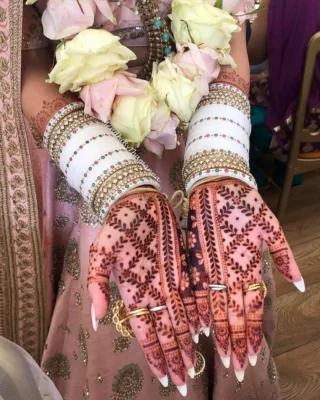
This timeless and classic bridal accessory is not only a reflection of cultural significance but also an element to beautify the bride’s look. Traditionally worn by Punjabi brides, the chooda is flaring up to become an essential component for brides of every region. Quintessential brides who feel a deep connection to their roots choose red chooda for their nuptials, while ultra-modern brides are opting for a unique and unconventional style of chooda. Kiara Advani looked mesmerising and broke the monotony by adorning a pink chooda that perfectly complemented her pastel lehenga. White bridal chooda is stealing the show, Bollywood divas are opting for this neutral colour chooda and setting a new wave of trend. The saga of colourful chooda is eye-catching, adorn matching chooda with your bridal lehenga and look exceptionally gorgeous.





